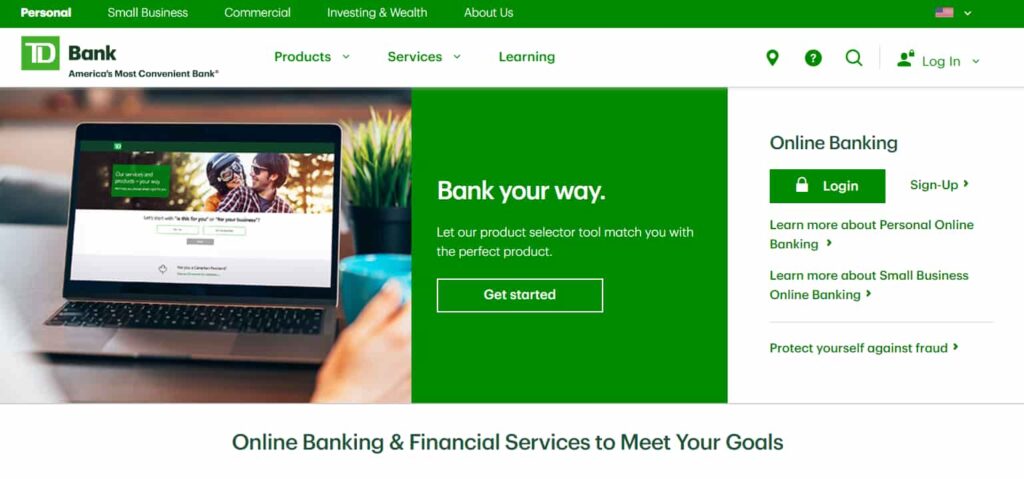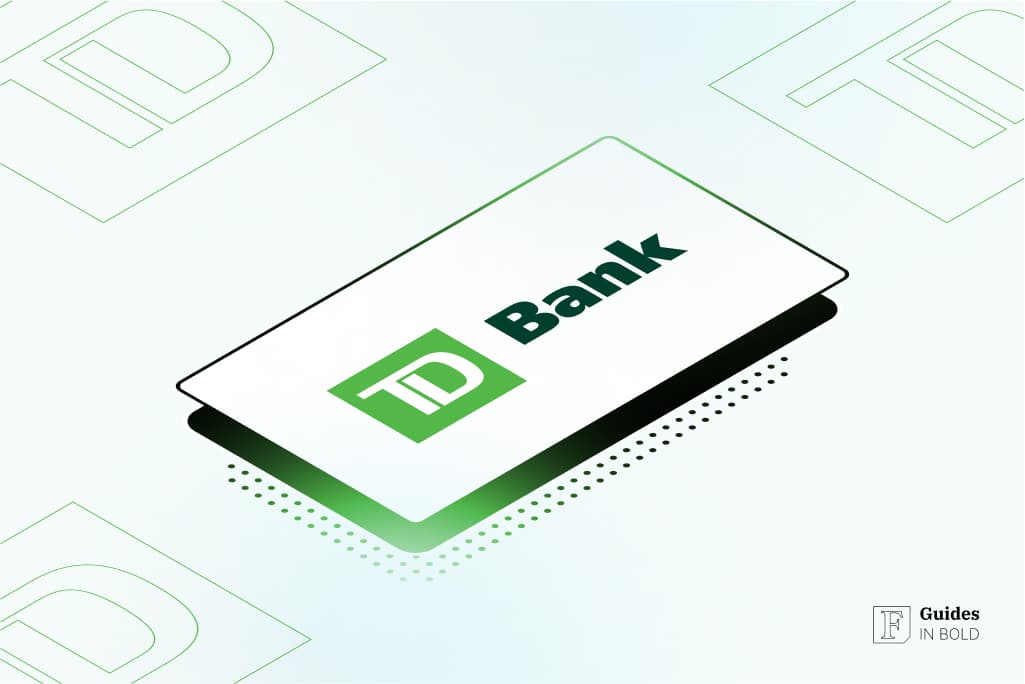Summary: Toronto-Dominion Bank (TSX: TD) stock is a popular option for investors. The most convenient way to buy TD Bank in Canada is through a regulated online brokerage, such as our go-to platform Interactive Brokers.
Best Platform for Worldwide Stock Trading & Investing
-
Highly trusted multi-asset broker with clients in over 200 countries
-
Trade on 150 markets globally from a single platform (stocks, ETFs, futures, currencies, crypto & more)
-
Low commissions starting at $0 with no platform fees or account minimums
-
Easily fund your account and trade assets in 26 currencies
-
IBKR pays up to 4.58% interest on cash balances of $10k or more
About TD Bank
Toronto-Dominion Bank is a prominent financial institution with a strong presence in North America. Since its foundation in 1855, it has grown to become one of the largest banks in both Canada and the United States. TD offers a wide range of financial services including banking, insurance, wealth management, and investment services. The bank is headquartered in Toronto, Canada, and has a reputation for its customer-centric approach and innovative offerings.

Is TD Bank publicly traded?
TD Bank is publicly traded on stock exchanges, making it accessible for investors to buy and own shares of the company. Its shares are listed under the ticker symbol TD on major stock exchanges, including the Toronto Stock Exchange (TSX) in Canada and the New York Stock Exchange (NYSE) in the United States.
How to buy TD Bank stock: Step-by-step process
In case you’re looking to buy TD Bank stock, you can follow our simple step-by-step guide right here, and you’ll be a shareholder in no time.
Step 1: Educate yourself
Before you start investing in TD Bank stock, it’s necessary to take some time to educate yourself about the stock market and basic investment concepts. The thing is—understanding key terms like stocks, dividends, and market trends will help you make more informed decisions. Only when you complete your research should you move on.
Step 2: Choose a brokerage account
To buy TD Bank stock, you’ll need a brokerage account. It serves as a platform that allows you to buy, sell, and hold stocks and other financial instruments. Therefore, be sure to research different brokerage options and choose one that aligns with your investment goals and preferences.
Our go-to brokerage for buying TD Bank stock is Interactive Brokers. Aside from being fully regulated and licensed by authorities like the Investment Industry Regulatory Organization of Canada (IIROC) and Canadian Investor Protection Fund (CIPF), it also provides:
- Low commissions and financing rates to maximize returns;
- Global access to stocks, futures, bonds, and funds;
- Trading efficiency with advanced technology;
- Secure trading experience.
Best Platform for Worldwide Stock Trading & Investing
-
Highly trusted multi-asset broker with clients in over 200 countries
-
Trade on 150 markets globally from a single platform (stocks, ETFs, futures, currencies, crypto & more)
-
Low commissions starting at $0 with no platform fees or account minimums
-
Easily fund your account and trade assets in 26 currencies
-
IBKR pays up to 4.58% interest on cash balances of $10k or more
Step 3: Fund your account
Once you’ve selected a brokerage, it will be time to fund your account with the amount of money you’re comfortable investing. Luckily, most brokerages accept various payment methods, from bank transfers to credit and debit cards. Nevertheless, make sure to consider your financial situation and only invest what you can afford to lose.
Step 4: Search for TD Bank stock
With funds in your account, you’ll be ready for the next step. This one includes searching for the TD Bank stock on your brokerage platform of choice. So, simply use the brokerage’s search function to find TD Bank stock. You can do so by entering the ticker symbol TD to locate the stock’s listing, and that’s it.
Step 5: Place an order
Next up, note that there are two main types of stock orders: market orders and limit orders.
- A market order will execute at the current market price;
- A limit order allows you to specify a price at which you’re willing to buy.
You should pick the order type that suits your strategy and enter the number of shares you want to purchase.
Step 6: Review and confirm
With an order type in place, you should once again double-check all the details of your order. By this, we mean the number of shares and the total cost. And only when you’re satisfied should you move on and confirm the order. At this point, the brokerage will process your order and execute the trade, and you’ll become a TD Bank shareholder.
Step 7: Monitor your investment
After buying TD Bank stock, you can track its performance through your brokerage account. Most novice investors will overlook this part. However, it’s key to pay attention to market trends, company news, and other relevant information that might impact the stock’s value so that you can adjust any details that might potentially hinder your investment.
TD stock price today

Pros
- Stable dividend: Consistent dividend payouts with a strong history of increases;
- Market leadership: One of Canada’s largest and most established banks;
- Diversified revenue streams: Strong domestic and US presence reduces reliance on a single market;
- Resilient business model: Historically performs well during economic fluctuations.

Cons
- Economic sensitivity: Heavily tied to the Canadian and US economies; downturns can affect profitability;
- Regulatory risks: Stricter regulations in the financial sector can impact growth;
- Exposure to real estate: High exposure to Canadian real estate market may pose risks during market corrections;
- Competition: Increasing competition from fintech companies and other banks.
What to avoid when buying stocks
Like all investing, buying stocks carries inherent risks. It’s, therefore, essential to be aware of common investing mistakes to avoid any potential pitfalls. As such, be wary of:
- Emotional decision-making: Making investment decisions based on emotions can lead to impulsive choices. You should, instead, stay rational and avoid reacting to short-term market fluctuations;
- Overlooking research: Before buying any stock, including TD Bank, conduct thorough research. Make sure that you understand the company’s financials, competitive landscape, and long-term prospects. Note that informed decisions are more likely to lead to successful investments;
- Ignoring diversification: Diversifying your investment portfolio across different industries and asset classes can help manage risk. So, avoid putting all your funds into a single stock, even if it’s a well-established company like TD Bank.
Disclaimer: The content on this site should not be considered investment advice. Investing is speculative. When investing, your capital is at risk.
FAQs about how to buy TD Bank stock
Can I buy TD Bank stock directly from the company?
No, you’ll need a brokerage account to buy TD Bank stock. Brokers like Interactive Brokers act as intermediaries between you and the stock market.
What is the minimum amount needed to invest in TD Bank stock?
The minimum investment amount varies depending on the brokerage you choose. However, some brokerages offer fractional shares, allowing you to invest with smaller amounts.
Do I need to be a Canadian resident to invest in TD Bank?
No, you can invest in TD Bank stock from anywhere in the world, as long as your chosen brokerage allows international investors, like Interactive Brokers.
How often does TD Bank pay dividends?
TD Bank typically pays dividends on a quarterly basis, but dividend schedules may vary. Therefore, be sure to check the latest information from the company to stay updated.
Best Platform for Worldwide Stock Trading & Investing
-
Highly trusted multi-asset broker with clients in over 200 countries
-
Trade on 150 markets globally from a single platform (stocks, ETFs, futures, currencies, crypto & more)
-
Low commissions starting at $0 with no platform fees or account minimums
-
Easily fund your account and trade assets in 26 currencies
-
IBKR pays up to 4.58% interest on cash balances of $10k or more




